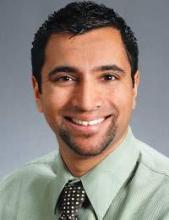Teens advised to rest for 5 days after a concussion reported more post-concussive symptoms than teens who rested for 1-2 days and gradually returned to activity, based on results of a randomized, controlled study of 88 adolescents, aged 11 to 22.
“Although poor compliance with strict physical rest may have contributed to a lack of efficacy, previous adult studies that have assessed strict rest after concussion found similar results,” lead author Dr. Danny George Thomas and his associates at the Medical College of Wisconsin in Milwaukee reported online. The researchers also noted that “adolescents’ symptom reporting may be influenced by restricting activity” (Pediatrics 2015 Jan. 5 [doi: 10.1542/peds.2014-0966]).
Study participants reported to the Children’s Hospital of Wisconsin Emergency Department and Trauma Center between May 2010 and December 2012 within 24 hours of a concussion or mild traumatic brain injury. Most had injured their head during sports, primarily football, and about a third had lost consciousness. Those with an IQ below 70, a mental health or developmental condition or learning disability, or an intracranial injury were excluded.
After an initial neurocognitive, balance, and symptom assessment in the emergency department, 45 participants were randomly assigned to strict rest and 43 controls were randomly assigned to usual care. (Initial randomization involved 99 participants, but 11 did not complete all procedures.)
Usual care involved 24-48 hours of rest, followed by a return to school and a stepwise return to physical activity after symptoms resolved. The strict rest group were instructed to rest for 5 days at home with no school, work, or physical activity, and then gradually return to activity.
In addition to maintaining daily diaries of physical and mental activities, energy exertion and post-concussive symptoms, the participants underwent neurocognitive and balance assessments again at 3 and 10 days after their injury. The post-concussive symptoms recorded in the daily diaries came from the 19-symptom post concussion symptom scale, which rated physical, cognitive, emotional and sleep domains from 0 (none) to 6 (severe).
Energy exertion and physical activity levels were approximately 20% lower during the first 5 days post-concussion in both groups, but those assigned to strict rest had lower school and after-school activity attendance and mental activity during the 2-5 days after their injuries.
The strict rest group spent an average 3.8 hours in school or after-school activities, compared to 6.7 hours among the usual care group (P<.05). The strict rest participants also reported an average 4.9 hours of moderate and high mental activity during days 2-5 post-concussion, compared to an average 8.3 hours among the usual care participants.
Post-concussion neurocognitive and balance assessments did not identify any significant differences between the two groups. However, the strict rest group had a total average symptom score of 188 over 10 days, compared to a total score of 132 for the usual care group (P<.03). Total post-concussive symptoms during follow-up numbered 70 in the strict rest group and 50 in the usual care group.
Approximately 63% of the strict rest participants had their symptoms fully resolve during follow-up, compared to 67% of the usual care participants. Although this difference was not significant, it took took 3 days longer for half of the strict rest group to report fully resolved symptoms.
Results tended to vary slightly, however, depending on individuals’ concussion history and their symptoms at diagnosis. Those who had a history of concussion or were diagnosed based only on post-concussive symptoms had a higher post-concussive symptom score on the 10th day after injury if assigned to strict rest. But, those still experiencing immediate concussion symptoms at diagnosis had slightly lower post-concussive symptom scores at day 10 on strict rest, and those with a first concussion showed no differences between groups in post-concussive symptoms at day 10.
“There are many potential explanations for the difference in symptom reporting,” Dr. Thomas’s team wrote. “It is possible that discharge instructions influenced the perception of illness, augmenting symptom reporting” or that the slightly older strict rest group were better able to articulate their symptoms.
The authors also suggested that emotional distress caused by restrictions on school and activities may have caused emotional distress.
“Missing social interactions and falling behind academically may contribute to situational depression increasing physical and emotional symptoms,” they wrote. “Similarly, activity restrictions and lack of exercise may contribute to sleep abnormalities and adversely affect mood. Alternatively, attending less school may have resulted in more time and fewer distractions to thoughtfully complete symptom diaries or perseverate on symptoms.”The research was funded by the Injury Research Center of the Medical College of Wisconsin. The authors reported no disclosures.

